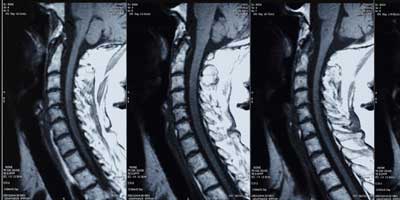Locations

Fax: (303) 762-9292

Explaining Spinal Disorders: Isthmic Spondylolisthesis
Isthmic Spondylolisthesis is a spinal condition in which one vertebra slips forward over the vertebra below. It is caused by a defect, or fracture, of the pars interarticularis; a bone connecting the upper and lower facet joints. The defect may be congenital and a fracture can be caused by the accumulative affects of spinal stress. Sometimes isthmic spondylolisthesis affects young athletes.
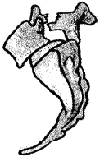
Slip of L5 vertebra on sacrum
*Isthmic spondylolisthesis most often occurs at L5-S1, the fifth lumbar vertebra and first sacral segment.
Symptoms
Although isthmic spondylolisthesis can cause spinal instability, not all patients find the condition painful. Symptoms of isthmic spondylolisthesis may include:
- Low back pain
- Sciatica
- Muscle spasms
- Leg weakness
- Tight hamstring muscles
- Irregular gait or limp
Causes
Isthmic spondylolisthesis may result from failure of bone to form properly. Accumulated physical stresses to the spine may cause weak or insufficiently formed vertebral structures (i.e. pars interarticularis) to break. Repeated heavy lifting, stooping over, or twisting may cause small fractures to occur and lead to a vertebral slip. Weightlifters, football players, and gymnasts may suffer from this disorder because of considerable spinal stress.
Diagnosis
Our comprehensive diagnostic process includes:
- Medical history. The doctor asks you questions about your symptoms, their severity, and treatments you have already tried.
- Physical examination. You are carefully examined for limitations of movement, problems with balance, and pain. During the exam, the doctor looks for loss of reflexes, muscle weakness, loss of sensation or other signs of neurological injury.
- Diagnostic tests. Most doctors start with x-rays. Isthmic spondylolisthesis may be seen on a lateral (side) lumbar x-ray. If necessary, a CT scan or MRI may be ordered to see the spine’s tissues in greater detail.
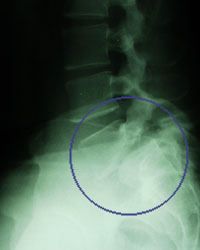
X-ray showing lumbar spondylolisthesis
Classification of Isthmic Spondylolisthesis
Information from your medical file and imaging studies is used to grade the degree of vertebral slippage from mild to severe. The grade of your spondylolisthesis is explained to you along with what it means.
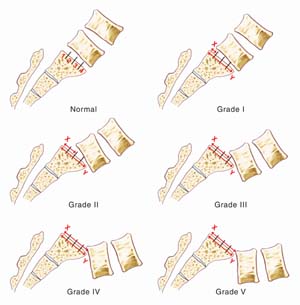
Doctors use the Meyerding Grading System to classify the degree of vertebral slippage. This system is easy to understand. Slips are graded on the basis of the percentage that one vertebral body has slipped forward over the vertebral body below.
- Grade I: 1-24%
- Grade II: 25-49%
- Grade III: 50-74%
- Grade IV: 75%-99% slip.
- Grade V: Complete slip (100%), known as spondyloptosis
Your doctor considers the degree of slip and factors, such as intractable pain and neurological symptoms, when deciding on the most suitable treatment. Most cases of isthmic spondylolisthesis are Grade I or II. As a general guideline, the more severe slips (Grades III and above) are most likely to require surgical intervention.
Nonoperative Treatment
Most cases of isthmic spondylolisthesis are treated without surgery. Treatment may include:
- Short-term bed rest
- Activity restriction
- Over-the-counter or prescription pain medication
- Anti-inflammatory medication
- Muscle relaxants
- Steroid injections (i.e. epidural steroid injection)
- Physical therapy
- Bracing
Isthmic spondylolisthesis can be progressive. This means the spondylolisthesis worsens with time. This is why it is important to follow-up with your doctor to monitor your treatment progress and spondylolisthesis.
Surgery
If your isthmic spondylolisthesis progresses or causes neurologic problems, such as incontinence, surgery may be recommended. Spinal instrumentation (i.e. rods, screws) and fusion (bone graft) are common procedures performed to stop slip progression and stabilize the spine. There are different types of instrumentation, bone graft and graft products, as well as procedures (some minimally invasive) to surgically treat isthmic spondylolisthesis. Your surgeon will explain how your surgery will be performed, as well as the benefits and risks of the procedure.
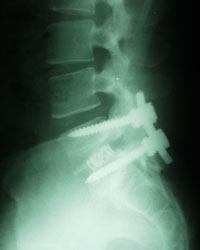
Post-operative x-ray showing corrective implants
Conclusion
Isthmic spondylolisthesis does not mean you have to live in pain. We can help you return to a healthy, pain-free and active life. For most patients this is accomplished with nonsurgical treatments. But, even if surgery is needed, be assured we will discuss all procedure risks and benefits and provide you with the best possible care.
In addition treatments, our medical professionals have a deep commitment to patient education. By helping you understand the cause of your condition, we can help you eliminate risk factors and instill spine healthy habits for a lifetime. While you are under our care, our medical staff will provide you with excellent information to help you recover, minimize risk factors, and stay healthy.





